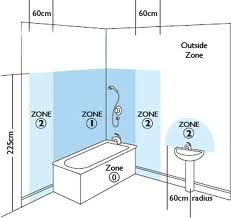17th edition of the IEE Wiring Regulations
the zones - protection - equipment
for bathrooms - use of equipment
This post is given for guidance only, always refer to the current IEE Wiring Regulations
or a qualified electrician to ensure that you are guided by the latest regulations/code of practice.
The zones
The 17th Edition of the IEE Wiring Regulations redefined the zones for electical equipment in bathrooms and must be used for installations designed after 30th June 2008. They are now identified from 0 to 2, with 0 being the wettest - the previous zone 3 is no longer defined.
- Zone 0
- The interior of the bath or shower which can hold water.
- Zone 1
- The area directly above zone 0 limited vertically to 2.25m above the bottom of the bath or shower.
Also 1.2m horizontally from the centre of a shower outlet to the height of the outlet or 2.25m whichever is the higher. - Zone 2
- The area beyond zones 0 and 1, 0.6m horizontally and up to 2.25m vertically. Zone 2 also included any recessed window with a sill next to the bath.
- Providing that the space under the bath cannot be accessed without using tools (i.e. screwdriver etc), that space is considered to be 'out of scope'.
Protection
All electrical circuits within bathrooms must be protected by Residual Current Devices (RCD) not excedding 30mA. This applies all electical equipment whether it is controlled a switch in the bathroom or remotely switched.Equipment for bathrooms
Electrical equipment may be identified as having a certain level of mechanical and moisture protection, these are quoted as 'Ingress Protection' (or IP) numbers - such as 'IPXY', where X and Y are numbers, the X showing the level of mechanical protection and Y showing the level of moisture protection - in both cases, the higher the number, the better the protection. If a piece of equipment does not have an IP number, it must not be used in zones 0, 1 or 2 (or elsewhere having a wet/damp environment).Typical electrical items which are marked with IP numbers include:
- Extractor fans
- Lighting
- Heaters
- Electrical shower units
- Shower pumps
As well as IP numbers, items may be classed as PELV or SELV.
- Protective Extra-Low Voltage (PELV) - As the name suggests, the item uses low voltage but it is connected to earth.
- Separated Extra-Low Voltage (SELV) - Again a low voltage system but the output is isolated from the input.
Use of Equipment
Any electrical item approved for use in a zone may be used in another zone with a higher number, but not in a lower number zone.- Zone 0
- Requires electrical products to low voltage (max. 12 volts) and be IPX7 (the mechanical protection is unimportant).
- Zone 1
- Requires electrical products to be IPX4 or better, or SELV with the transformer located beyond zone 2.
- Zone 2
- Requires electrical products to be IPX4 or better, or SELV with the transformer located beyond zone 2.
- Beyond zone 2
- When the size of bathroom extends beyond zone 2, portable equipment is allowed, however they should be positioned such that
that their flex length does not enable them to be used in zone 2.

Method to ensure on qualified persons are allowed in the limited approach or arc flash boundaries Used Lab Equipment Auction
ReplyDelete